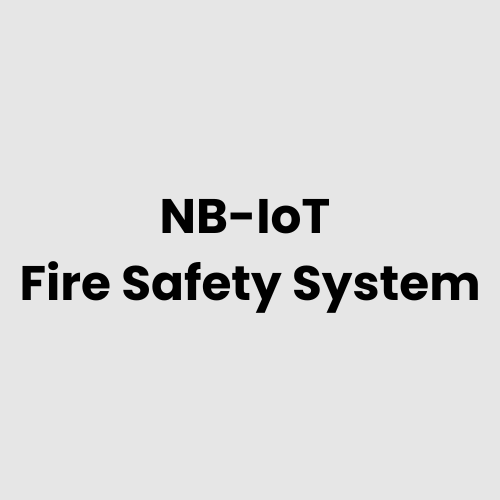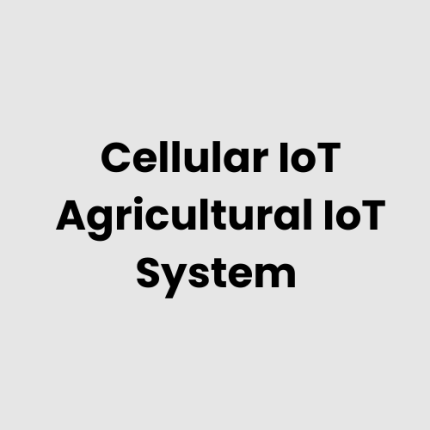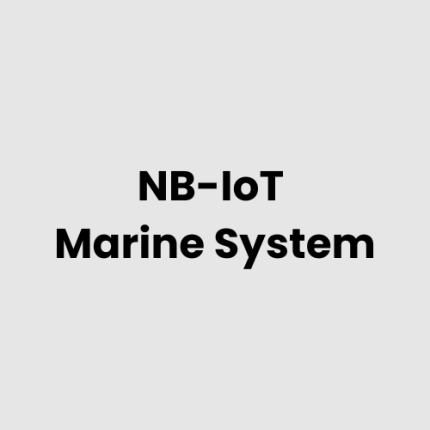Description
The NB-IoT Enabled Fire Safety IoT System is designed to provide continuous fire monitoring and prevention capabilities in both commercial and industrial environments. The system employs the use of Narrowband IoT (NB-IoT) technology for reliable, low-power, and wide-area network connectivity. The architecture is made up of sensors, gateways, a central monitoring server, and cloud-based data management, enabling real-time fire detection, alert notifications, and data analytics.
- Sensors: Distributed across the premises, the system uses smoke, heat, gas, and flame detectors, all connected to the network via NB-IoT.
- Gateways: Collect data from the sensors and transmit it over the NB-IoT network to a centralized server for processing.
- Central Server: Gathers and processes the data from all connected sensors and devices, triggers alerts, and performs initial diagnostics.
- Cloud Integration: The system can seamlessly sync data to the cloud for remote monitoring, management, and advanced analytics.
Hardware of the NB-IoT Enabled Fire Safety IoT System:
- Smoke Detectors: Wireless NB-IoT enabled smoke sensors for fire detection.
- Heat Sensors: Devices that monitor temperature levels and detect potential fire risks.
- Gas Sensors: For detecting dangerous gas leaks like carbon monoxide or methane.
- Flame Detectors: Sensors that detect the presence of fire through visible light and infrared.
- Gateways: Secure IoT gateways for connecting sensors to the NB-IoT network.
- Centralized Monitoring Server: To process incoming sensor data and issue alerts.
- Control Panel: Allows on-site operators to manually monitor and respond to sensor data and alarms.
Physical Placement Considerations:
- Smoke Detectors: Installed on ceilings or walls at strategic locations such as corridors, rooms, and near high-risk areas.
- Heat Sensors: Placed near machinery, electrical panels, and areas where temperature fluctuations may indicate potential fire hazards.
- Gas Sensors: Located in areas prone to gas accumulation, such as kitchens, basements, and industrial sites.
- Flame Detectors: Mounted in open spaces with direct line-of-sight to high-risk zones like factories or warehouses.
- Gateways: Positioned in central locations to maximize coverage of the sensor network and ensure stable communication with the IoT network.
Hardware Architecture:
The NB-IoT Enabled Fire Safety IoT System is designed to optimize both physical and digital infrastructure for seamless monitoring. The architecture integrates sensor nodes, gateways, a centralized server, and cloud capabilities. Sensors are distributed across the premises, connecting wirelessly through a gateway that acts as an intermediary to transmit data. The system is capable of managing numerous devices and data points in real time, with all data being securely processed and stored.
Deployment Considerations:
- Scalability: The system can be deployed across a variety of facility sizes, from small buildings to large industrial complexes.
- Network Coverage: Ensure that the NB-IoT network coverage is strong across the entire facility to support the sensors and gateways.
- Power Supply: Sensors and gateways must be installed with stable and consistent power sources, with some sensors capable of running on battery for extended periods.
- Maintenance: The system requires regular maintenance checks, including cleaning of detectors and recalibration of sensors to ensure continued accuracy.
- Security: Ensure encrypted communication and secure access to the central server to protect sensitive data.
Relevant Industry Standards and Regulations:
- NFPA 72: National Fire Alarm and Signaling Code
- ISO 7240: Fire detection and fire alarm systems
- UL 268: Smoke Detectors for Fire Alarm Systems
- EN 54: European Standard for Fire Detection and Alarm Systems
- IEC 61508: Functional Safety
- GDPR: General Data Protection Regulation (for cloud data storage)
Local Server Version:
In a local server setup, the NB-IoT Enabled Fire Safety IoT System operates independently of the cloud, with data being processed and stored on an on-premise server. This setup allows for complete control and quicker response times in emergency situations. Data analytics, alerts, and diagnostics can be conducted locally, with remote access available through a secure VPN connection. Local servers can be configured to integrate with existing fire safety protocols.
Cloud Integration and Data Management:
The NB-IoT Enabled Fire Safety IoT System offers seamless integration with cloud platforms, providing centralized access to real-time data from any location. Through cloud data management, the system enables remote monitoring of fire safety conditions across multiple sites. Historical data can be analyzed for trends, predictive maintenance can be carried out, and actionable insights can be generated. Furthermore, cloud integration allows for the use of machine learning algorithms to predict potential fire hazards and improve system response times.
GAO Case Studies of NB-IoT Enabled Fire Safety IoT System
USA Case Studies
- New York City, USA
In a commercial high-rise building in New York, the NB-IoT Enabled Fire Safety IoT System was implemented to ensure comprehensive fire detection and response across multiple floors. The system enabled real-time monitoring, providing early detection and timely alerts, significantly enhancing fire safety protocols while reducing response time during emergencies. Learn more about fire safety standards on NFPA. - San Francisco, USA
At a tech company campus in San Francisco, the integration of NB-IoT fire safety sensors throughout the office spaces improved the early detection of fire hazards. The system’s seamless connection to a centralized monitoring platform enabled rapid response and greater operational continuity, aligning with local fire safety regulations. - Los Angeles, USA
The installation of NB-IoT fire safety sensors in a large retail mall in Los Angeles enabled continuous monitoring of high-risk areas. The system’s automatic alerts to the fire control center helped mitigate potential fire hazards and ensured faster evacuations, contributing to improved safety in a high-traffic environment. Learn more about smart building technologies at Buildings.com. - Chicago, USA
In Chicago’s industrial district, a factory equipped with the NB-IoT Enabled Fire Safety IoT System experienced enhanced protection for both machinery and personnel. The system’s gas, smoke, and heat detectors provided early warnings of potential fire risks, helping to avoid costly downtimes and safeguarding the facility’s infrastructure. Check out the Fire Safety Engineering association for best practices. - Dallas, USA
A major office building in Dallas implemented an NB-IoT-enabled fire safety system to provide constant monitoring across several floors. The integration of smoke and heat detectors allowed for instant alerts to the facility management team, reducing emergency response times and improving overall fire prevention measures. Explore fire risk management strategies from OSHA. - Miami, USA
In Miami, a hotel chain integrated NB-IoT fire safety solutions to monitor multiple properties simultaneously. The system’s smart detectors sent real-time alerts for any fire risks, allowing the management team to react swiftly and prevent potential fire incidents from disrupting guest services. Discover more about fire safety at IFSTA. - Seattle, USA
A data center in Seattle deployed an NB-IoT Enabled Fire Safety IoT System to safeguard its critical infrastructure. With sensors placed throughout the building, the system detected heat and smoke early, sending alerts to both the central control and security teams, ensuring the facility remained operational and safe. Learn more about data center security at Data Center Knowledge. - Houston, USA
A large warehouse in Houston benefited from the NB-IoT system’s smart smoke and gas detectors, ensuring the early detection of fire hazards. The system’s centralized monitoring capabilities allowed the facility management team to act quickly and efficiently, protecting both inventory and employees. Explore warehouse safety guidelines at National Safety Council. - Atlanta, USA
In Atlanta, a high-traffic shopping mall deployed NB-IoT-enabled fire safety sensors to monitor its vast interior. The system’s sensors alerted the management team of any smoke or heat anomalies, allowing them to respond quickly and evacuate patrons if necessary, enhancing public safety. Visit Mall Management for related industry insights. - Boston, USA
At a historic building in Boston, NB-IoT fire safety technology was integrated to preserve the structure while ensuring fire risks were monitored. The system, featuring flame, smoke, and heat sensors, provided a modern solution to maintaining fire safety standards in an older building with a complex layout. Learn more about historic building safety at National Trust for Historic Preservation. - Denver, USA
In a healthcare facility in Denver, the NB-IoT Enabled Fire Safety IoT System ensured the protection of sensitive areas like patient rooms and medical equipment storage. Real-time monitoring provided accurate early warnings of fire hazards, allowing medical staff to take immediate actions and evacuate if necessary. Explore healthcare fire safety regulations at CDC. - Washington, D.C., USA
A government office building in Washington, D.C., relied on NB-IoT fire safety systems to ensure the security of government personnel and important data. The system’s smoke and gas detectors allowed for proactive responses to fire risks, reducing the potential for loss and improving safety compliance. Visit FEMA for government safety protocols. - Phoenix, USA
A large retail chain in Phoenix installed an NB-IoT fire safety system to protect its inventory and customers. The system’s smoke detectors and heat sensors were strategically placed throughout the store, and the system ensured early detection of any anomalies, helping staff react quickly during emergencies. Discover fire prevention guidelines at Fire Engineering. - Orlando, USA
In an amusement park in Orlando, the NB-IoT fire safety system was deployed across attractions and service areas. The system provided continuous monitoring of heat and smoke, helping park operators respond immediately to potential fire hazards, ensuring visitor safety and minimizing operational downtime. Visit Amusement Park Safety for related industry insights. - Las Vegas, USA
In Las Vegas, a luxury hotel integrated NB-IoT fire safety systems to monitor smoke, gas, and temperature in its rooms and common areas. The system provided automated alerts to both on-site staff and the central monitoring center, enabling a quicker response to fire risks and improving overall guest safety. Learn about hospitality safety standards at AHLA.
Canada Case Studies
- Toronto, Canada
In Toronto, an office complex equipped with an NB-IoT Enabled Fire Safety IoT System was able to monitor multiple floors for fire risks continuously. The system provided real-time alerts for fire incidents, allowing management to act quickly and efficiently, improving tenant safety and meeting building code requirements. Explore building safety standards at Toronto Building Code. - Vancouver, Canada
A warehouse in Vancouver deployed the NB-IoT fire safety system to detect and alert any early signs of fire. With NB-IoT’s reliable coverage, the system provided real-time status updates to both the central server and security personnel, enhancing the fire safety response while preventing costly damages. Learn more at WorkSafeBC.
Navigation Menu for NB-IoT:
Navigation Menu for IoT
- LORAWAN
- Wi-Fi HaLow
- Z-WAVE
- BLE & RFID
- NB-IOT
- CELLULAR IOT
- GPS IOT
- IOT SENSORS
- EDGE COMPUTING
- IOT SYSTEMS
Our products are in stock and can be shipped anywhere in the continental U.S. or Canada from our local warehouse. For any further information, please fill out this form or email us.
We are actively looking for partners who are like us located in the U.S. and Canada. For more information on partnering with GAO, please visit Partner with GAO Tek Inc.It lists various ways to partner with GAO, such as OEM Partnerships, Technology Integration, Distribution and Reselling Opportunities, Presenting at the Leading Event Tek Summit, Joint R&D Projects, Training and Consulting Services, Industry-Specific Collaborations, Research and Academic Partnerships.



